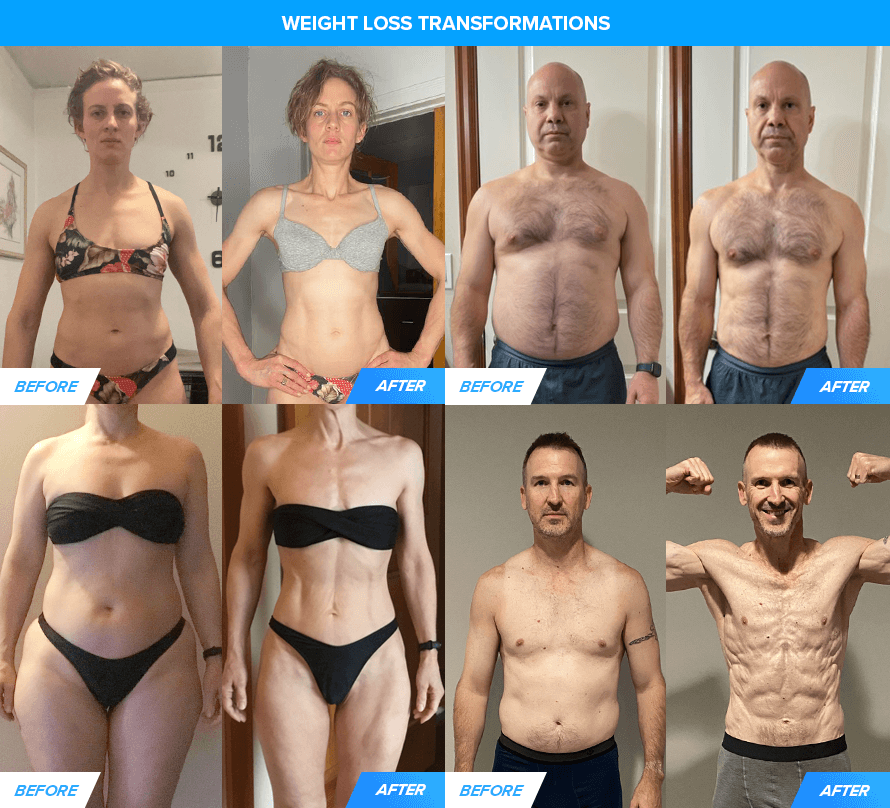“What ought to my macros be to drop some weight?”
It seems like a easy query, however it stumps even probably the most skilled dieters. And it’s no surprise why—misinformation about counting macros for fats loss is all over the place.
For example, social media fats loss “specialists” typically declare their “distinctive” strategy is the one technique to shed kilos shortly and healthily.
However the fact?
There’s no single “excellent” macro ratio for fats loss that works for everybody. That mentioned, science does recommend some macro ratios work higher for fats loss than others.
What are these evidence-based percentages?
Right here’s the breakdown:
- Protein: 30-to-40% of energy
- Carbohydrates: 30-to-50% of energy
- Fats: 20-to-30% of energy
On this article, you’ll be taught why these ratios work, easy methods to calculate them based mostly in your way of life, and easy methods to regulate them as your physique adjustments. By the tip, you’ll have a science-backed plan to make fats loss as quick and easy as doable.
Key Takeaways:
- Monitoring your macros is crucial for weight reduction, because it helps you management your calorie consumption whereas preserving muscle, sustaining vitality, and supporting total well being.
- There’s no single “excellent” macro ratio for fats loss, however some methods work higher than others.
- Step one in counting macros for weight reduction is making a calorie deficit. Most individuals have success by consuming 20-to-25% fewer energy than they burn every day.
- A balanced macro ratio for fats loss typically consists of 30-to-40% of energy from protein, 30-to-50% from carbohydrates, and 20-to-30% from fats.
- As you drop some weight, you’ll want to regulate your macros to maintain seeing outcomes. When weight reduction stalls, an excellent technique is to decrease your every day calorie consumption by 100-to-150 energy by decreasing carbs.
What Are Macros and Why Do They Matter for Weight Loss?


A macronutrient (“macro”) is a nutrient your physique wants in massive quantities to perform correctly. Whereas the time period technically consists of minerals, we’ll concentrate on the three macros that matter most for weight reduction: protein, carbohydrates, and fats.
Monitoring your macros helps you management your calorie consumption and enhance your physique composition. It’s particularly efficient whereas weight-reduction plan to drop some weight as a result of it lets you handle your vitality ranges and optimize your well being whereas weight-reduction plan.
Merely put, balancing your macros makes shedding fats extra wholesome, environment friendly, and sustainable.
What Are the Good Macro Percentages for Weight Loss?
“Macro percentages” or a “macro ratio” refers back to the proportion of your every day calorie consumption that comes from protein, carbohydrates, and fats.
Regardless of what many weight loss plan “gurus” declare, there’s no magic macro ratio for fats loss. Analysis exhibits you can drop some weight with quite a lot of macronutrient distributions—what issues most is that you just preserve a calorie deficit.
That mentioned, analysis additionally means that some methods make fats loss simpler for most individuals:
- Consuming extra protein helps protect muscle and may hold you feeling full, which usually makes weight-reduction plan more healthy and extra simple.
- Consuming a average quantity of carbs retains your vitality ranges up, which makes weight-reduction plan extra satisfying and sustainable. That is very true for those who carry weights since low-carb diets can drain your vitality and crush your motivation to coach.
- Consuming an ample quantity of wholesome fat is paramount for hormone manufacturing and total well-being.
In different phrases, whereas there’s no single “excellent” macro ratio, science suggests sure distributions are more practical for fats loss than others.
The way to Rely Macros to Lose Weight: Science-Primarily based Ratios


As we’ve established, there’s no one-size-fits-all macro ratio for fats loss. Nonetheless, analysis provides us clear tips on macro breakdowns that work effectively for most individuals.
Don’t simply take my phrase for it—try a number of the shoppers from my physique transformation teaching program. They adopted the evidence-based macro ratios we’re about to cowl and achieved unimaginable outcomes:


Able to see comparable success?
Right here’s your step-by-step information to counting macros for weight reduction, designed to make reaching your physique composition objectives as environment friendly and simple as doable.
Step 1: Calculate Your Every day Calorie Consumption
To lose fats, it’s a must to eat fewer energy than you burn.
However what number of energy must you goal for?
Research present that consuming 20-to-25% fewer energy each day is the candy spot. It’ll assist you to shed fats lickety-split with out shedding muscle or wrestling with extreme starvation, lethargy, and the opposite hobgoblins of low-calorie weight-reduction plan.
You will have two choices for determining what number of energy this interprets to for you:
- Use the Legion Calorie Calculator: That is the best technique to get an correct calorie goal.
- Estimate energy based mostly in your weight and exercise stage: Eat 8-to-12 energy per pound of physique weight per day relying on how a lot train you do.
Right here’s how to decide on the precise quantity based mostly on how lively you’re:
- Sedentary (little to no train): Go along with the bottom finish—8 energy per pound.
- Evenly Energetic (1-to-3 hours of train per week): Choose the center of the vary—9-to-10 energy per pound.
- Reasonably Energetic (4-to-7 hours of train per week): Go for the excessive finish—12 energy per pound.
- Very Energetic (8+ hours of coaching per week): It’s possible you’ll want greater than 12 energy per pound to keep up a wholesome deficit (~14-to-16 energy), relying on how a lot vitality you burn. As a result of exercise ranges range a lot, the Legion Calorie Calculator is your finest wager for pinpointing your actual wants.
Step 2: Set Your Macro Ratio for Fats Loss
Now that you’ve got your every day calorie goal, divide these energy into protein, carbs, and fat. Right here’s an evidence-based macronutrient breakdown for weight reduction:
- Protein: Eat 1 gram of protein per pound of physique weight per day, and for those who’re very obese, 0.6-to-0.8 grams per pound of physique weight per day is adequate. This normally comes out to round 30-to-40% of every day energy.
- Carbs: Eat 30-to-50% of your every day energy from carbohydrate—about 0.75-to-2 grams of carbs per pound of physique weight per day for most individuals.
- Fats: Eat 20-to-30% of every day energy from fats—about 0.2-to-0.4 grams of fats per pound of physique weight per day for most individuals.
Step 3: Alter Primarily based on Your Outcomes
Many individuals mistakenly imagine that when they calculate their macros for weight reduction, they will hold utilizing the identical numbers ceaselessly—however that’s not how the physique works. As you drop some weight, your physique burns fewer energy, each since you weigh much less and your metabolism slows to preserve vitality.
Your physique additionally turns into extra environment friendly at utilizing the energy it does get. It even reduces spontaneous motion, like fidgeting or transferring round, which additional decreases calorie expenditure.
Over time, these adjustments shrink your calorie deficit, and weight reduction slows. To proceed shedding fats at this level, it’s essential widen the hole between the vitality you eat and the vitality you burn.
Right here’s how:
- When weight reduction stalls regardless of “maxing out” on train and planning and monitoring your meals consumption exactly, scale back your every day calorie consumption by 100-to-150 energy per day by reducing your carb consumption. This may normally “purchase” you one other 7-to-10 days of fats loss.
- When weight reduction stalls once more, scale back your vitality consumption by an extra 100-to-150 energy per day, once more by decreasing carbs.
- Proceed making these small changes till you attain your objective.
READ MORE: Stopped Shedding Weight? Right here’s Why (and The way to Repair It)
FAQ #1: Is 40/30/30 an excellent macro ratio for weight reduction?
Sure, the “40/30/30” macro ratio—40% of energy from carbs, 30% from protein, and 30% from fats—can work effectively for weight reduction. It gives sufficient protein to protect muscle and really feel full, sufficient carbs to maintain your vitality up and make your weight loss plan satisfying, and sufficient fats to assist wholesome hormone perform.
Nonetheless, what’s much more essential than getting the macro breakdown excellent is ensuring you’re in a calorie deficit. No macro ratio will assist you to drop some weight for those who’re consuming too many energy. So, whereas 40/30/30 is a balanced and efficient framework, concentrate on getting your calorie consumption proper first.
RELATED: Calorie Calculator: How Many Energy Ought to You Eat?
FAQ #2: What’s the finest macro ratio for fats loss?
There’s no one-size-fits-all macro ratio for fats loss. That mentioned, analysis suggests some methods work higher than others.
The next protein consumption—about 30-to-40% of your every day energy—helps protect muscle and retains you full, making it simpler to stay to your weight loss plan.
Carbs ought to make up 30-to-50% of your consumption that will help you preserve vitality, particularly for those who carry weights. The remaining 20-to-30% ought to come from fat to assist hormone perform and total well being.
FAQ #3: How do you hit your macros for weight reduction?
Hitting your macros requires accuracy and consistency. Listed here are some sensible steps:
- Use Dietary Labels: For packaged meals, begin with the vitamin data on the label. Double-check serving sizes to make sure you’re logging the correct quantity.
- Prepare dinner at Dwelling: Making ready most of your meals at residence with minimally processed substances makes monitoring easier and extra correct. Use dependable assets like CalorieKing, SELF Diet Knowledge, or the USDA Meals Composition Databases to search out dietary data for meals with out labels.
- Weigh Your Meals: Use a meals scale to weigh all the things earlier than cooking. For meals that don’t require cooking, weigh them earlier than consuming. Utilizing weight (in ounces or grams) is much extra correct than utilizing quantity measurements, like cups or tablespoons, which may simply result in miscalculations.
- Monitor The whole lot: Embrace all meals in your meal plan—greens, fruits, condiments, oils, and any extras you eat. Even small gadgets like a dab of butter or a tablespoon of dressing can add up and influence your outcomes.
By being diligent and exact, you possibly can make sure you’re hitting your macros precisely, which is vital to profitable and sustainable weight reduction.
Scientific References +
- Kim, Ju Younger. “Optimum Food plan Methods for Weight Loss and Weight Loss Upkeep.” Journal of Weight problems & Metabolic Syndrome, vol. 30, no. 1, 27 Oct. 2020, pp. 20–31, www.ncbi.nlm.nih.gov/pmc/articles/PMC8017325/, https://doi.org/10.7570/jomes20065.
- Ge, Lengthy, et al. “Comparability of Dietary Macronutrient Patterns of 14 Well-liked Named Dietary Programmes for Weight and Cardiovascular Danger Issue Discount in Adults: Systematic Evaluation and Community Meta-Evaluation of Randomised Trials.” The BMJ, vol. 369, no. 369, 1 Apr. 2020, www.ncbi.nlm.nih.gov/pmc/articles/PMC7190064/?report=printable#ref15, https://doi.org/10.1136/bmj.m696.
- Gardner, Christopher D., et al. “Impact of Low-Fats vs Low-Carbohydrate Food plan on 12-Month Weight Loss in Chubby Adults and the Affiliation with Genotype Sample or Insulin Secretion.” JAMA, vol. 319, no. 7, 20 Feb. 2018, p. 667, jamanetwork.com/journals/jama/fullarticle/2673150, https://doi.org/10.1001/jama.2018.0245.
- Moon, Jaecheol, and Gwanpyo Koh. “Scientific Proof and Mechanisms of Excessive-Protein Food plan-Induced Weight Loss.” Journal of Weight problems & Metabolic Syndrome, vol. 29, no. 3, 30 Sept. 2020, pp. 166–173, www.ncbi.nlm.nih.gov/pmc/articles/PMC7539343/, https://doi.org/10.7570/jomes20028.
- Li, Shiyu, et al. “Adherence to Ketogenic Food plan in Life-style Interventions in Adults with Chubby or Weight problems and Sort 2 Diabetes: A Scoping Evaluation.” Diet & Diabetes, vol. 13, no. 1, 14 Sept. 2023, p. 16, pubmed.ncbi.nlm.nih.gov/37709770/, https://doi.org/10.1038/s41387-023-00246-2.
- Kumar, Nitya Kalyani , et al. Adherence to Low-Carbohydrate Diets in Sufferers with Diabetes: A Narrative Evaluation. 18 Feb. 2022.
- Zajac, Adam, et al. “The Results of a Ketogenic Food plan on Train Metabolism and Bodily Efficiency in Off-Street Cyclists.” Vitamins, vol. 6, no. 7, 27 June 2014, pp. 2493–2508, www.ncbi.nlm.nih.gov/pmc/articles/PMC4113752/, https://doi.org/10.3390/nu6072493.
- Bandini, Linda G., et al. “Metabolic Variations in Response to a Excessive-Fats vs. a Excessive-Carbohydrate Food plan.” Weight problems Analysis, vol. 2, no. 4, July 1994, pp. 348–354, https://doi.org/10.1002/j.1550-8528.1994.tb00074.x. Accessed 26 Sept. 2021.
- Helms, Eric R, et al. “Proof-Primarily based Suggestions for Pure Bodybuilding Contest Preparation: Diet and Supplementation.” Journal of the Worldwide Society of Sports activities Diet, vol. 11, no. 1, 12 Could 2014, https://doi.org/10.1186/1550-2783-11-20.
- Huovinen, Heikki T., et al. “Physique Composition and Energy Efficiency Improved after Weight Discount in Male Athletes with out Hampering Hormonal Steadiness.” Journal of Energy and Conditioning Analysis, vol. 29, no. 1, Jan. 2015, pp. 29–36, https://doi.org/10.1519/jsc.0000000000000619.
- Helms, Eric R, et al. “Proof-Primarily based Suggestions for Pure Bodybuilding Contest Preparation: Diet and Supplementation.” Journal of the Worldwide Society of Sports activities Diet, vol. 11, no. 1, 12 Could 2014, https://doi.org/10.1186/1550-2783-11-20.
- Hen, Stephen. “Energy Diet: Maximizing Your Anabolic Potential.” Energy and Conditioning Journal, vol. 32, no. 4, Aug. 2010, pp. 80–86, https://doi.org/10.1519/ssc.0b013e3181d5284e.
- Weigle, D S. “Contribution of Decreased Physique Mass to Diminished Thermic Impact of Train in Lowered-Overweight Males.” Worldwide Journal of Weight problems, vol. 12, no. 6, 1988, pp. 567–78, pubmed.ncbi.nlm.nih.gov/3235273/.
- Martin, Corby Ok., et al. “Impact of Calorie Restriction on Resting Metabolic Fee and Spontaneous Bodily Exercise**.” Weight problems, vol. 15, no. 12, Dec. 2007, pp. 2964–2973, https://doi.org/10.1038/oby.2007.354.
- Redman, Leanne M., et al. “Metabolic and Behavioral Compensations in Response to Caloric Restriction: Implications for the Upkeep of Weight Loss.” PLoS ONE, vol. 4, no. 2, 9 Feb. 2009, p. e4377, https://doi.org/10.1371/journal.pone.0004377. Accessed 3 Could 2020.
- Weigle, D S, and J D Brunzell. “Evaluation of Power Expenditure in Ambulatory Lowered-Overweight Topics by the Strategies of Weight Stabilization and Exogenous Weight Substitute.” Worldwide Journal of Weight problems, vol. 14 Suppl 1, 1990, pp. 69–77;dialogue 77-81, pubmed.ncbi.nlm.nih.gov/2228420/.
- Trexler, Eric T, et al. “Metabolic Adaptation to Weight Loss: Implications for the Athlete.” Journal of the Worldwide Society of Sports activities Diet, vol. 11, no. 11, 27 Feb. 2014, p. 7, https://doi.org/10.1186/1550-2783-11-7.










Discussion about this post